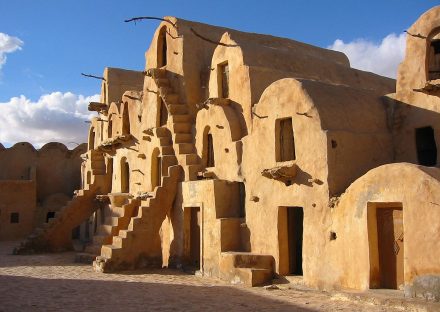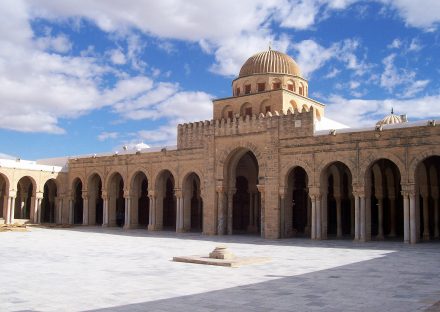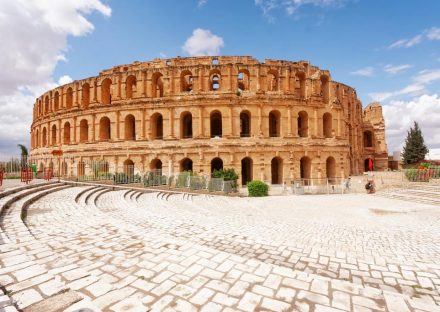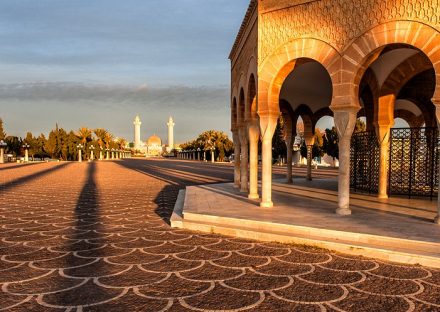- Details
- Itinerary
- Location
- Photos
Tour overview
Sidi Bou Said- Kerkouane- El Haouaria- Kelibia- Nabeul- Hammamet-Kairouan-Sbeitla-Tozeur-Douz-Matmata-Sfax-El Jem-Monastir-Sousse-Zaghouan-Douga-Tunis
Stunning coastline, vibrant culture and an opulent history, it’s not surprising that Tunisia is the destination of choice for millions of holidaymakers every year. And we have much to offer all our travelers. You’ll stroll through the streets of Sidi Bou Said, will visit the Bardo Museum, will walk through Hammamet’s maze of narrow and winding lanes within the town’s medina, will see the best-preserved remains of the Carthaginian civilization.
Day 1
Arrival at Tunis Carthage airport, assistance and transfer to your hotel in Sidi Bou Said. Check in, dinner and accommodation.
Day 2
After breakfast visit Sidi Bou Said: stroll through the narrow streets of Sidi Bou Said, a picturesque small town bordered by white-washed houses with blue shutters and doors. Check out the various art galleries and try some mint tea in one of the traditional street cafes while enjoying the superb view of the gulf of Tunisia. Then, spend some leisure time to indulge in shopping. Departure to Explore Carthage, the capital of ancient Carthaginian Empire. Visit Birsa Hill to see the ruins of Roman buildings and Carthage Museum. See the Tophet, where urns containing the ashes and milk teeth of 8th century BC children have been unearthed. Visit Antonine Baths, a huge Roman bath complex on the edge of the Mediterranean. Visit the theatre and Punic Port. Visit of Bardo Museum (closed on Mondays), one of the best archaeological museums in the Mediterranean, which is especially well known for its beautiful collection of mosaics. The museum is located in an old palace that belongs to the Beys, rulers of Tunisia. Visit the Medina of Tunis where we will see the “old Tunisia” which includes the Medina, the ‘European’ quarter built at the beginning of the 20th century and the new modern suburbs. For more than 500 years, the Medina has been the historic heart of Tunis and UNESCO has classified it as a World Heritage Site due its fascinating and exotic maze of streets. We will stop by the Zaitouna Mosque (from outside), mosque of Sidi Mehrez and the mausoleum of the Husainides princes. Return to the hotel, dinner and accommodation.
Sidi Bou Said is a famous tourist destination. Thousands of tourists stroll through the small city from different parts of the world. During the day, tourists walk along the narrow, stone-paved streets interacting with local vendors and residents. Traders have stalls on the sides of the streets selling unique items and souvenirs that portray the rich history of the city. The traders are very friendly to the visitors hoping to make a sale.
The Mausoleum of Abu Said Al-Baji offers great sightseeing views. This site offers incomparable views of the Carthage, the Gulf of Tunis and the capital itself, Tunis.
The National Museum of Carthage is located at the top of Birsa hill and displays objects removed from the archeological site. Filled with history, the artifacts help understand through the funeral rituals how did the Phoenicians and Romains lived in Carthage. Representative of the Punic era are the ceramics and amphorae. The sarcophagi are often decorated with carved figures and amulets symbols of the Egyptian divinity.
The Tunis Medina (Old Town) is a fascinating place to learn more about this North African city, which is the capital of Tunisia. The 9th century Medina was originally surrounded by walls. Today the walls are gone, but the area is filled with narrow streets, souks, mosques, and historic structures.
Day 3
After breakfast, checkout then departure to visit Kerkouane: on this archaeological site on the seafront are the best-preserved remains of the Carthaginian civilization: the ruins of a small city, with houses, a temple and ramparts. Continuation to El Haouaria, situated at the tip of the Cap Bon peninsula, a pretty blue and white village adjacent to imposing mines dating from Antiquity, the Grottes. Lunch in a restaurant (Fish menu). Departure to Kelibia: a visit to a charming fishing port close to a historic vestige and beautiful beaches, this lively fishing port is noteworthy for its 12th century fortress overlooking a magnificent panorama of the sea from the top of a hill. Departure to Nabeul: important handicrafts center most famous for pottery, distilled water from orange flowers, its roses and jasmine plants. It is a great town of trade with many specialties: pottery, matting of rush, embroidery, wrought iron. Visit of the market where the delectable produce overflows from the colorful stalls charged with citrus fruit, strawberries or fragrant flowers to be distilled. A visit to the Medina of Hammamet, installation in the hotel, dinner and overnight.
El Haouaria is on the northernmost tip of Cap Bon peninsula on the Sidi Abioud Mountain. It is a fairly sleepy coastal village of around 9,000 residents with a very remote air about it. It is also known by its Roman name of Aqualaria which means “country of eagles”. The main activity in the town is on Friday, the local market day. The white-washed buildings mostly look out on the inland fields and countryside rather than the Mediterranean. Just across the water to the east is Sicily, making this one of the narrowest points between Africa and Europe.
Surrounded by its original 15th-century walls, Hammamet's maze of narrow and winding lanes within the town's medina (old town) hosts a wealth of well-preserved traditional Tunisian architecture. Some of the alleyways have been covered, so even in the heat of summer; the medina remains cool and shady - making an exploration here a pleasant respite from the harsh sun. There are plenty of shopping opportunities, with local embroidery, ceramics, leather goods, and carpets all on display, though wares tend to be on the pricey side within the medina shops.
Day 4
After breakfast, checkout and depart to explore Kairouan, the city which bears its serenity of 13 century Islamic culture. Behold the wondrous beauty of its mosques, the symphony of its columns and arches and the exquisite delicacy of the stonework. Visit of the Great Mosque of Uqba Bin Nafi, an important Islamic landmark and architecture which was built in the 9th century. Next, visit the Aghlabiden pools and Sidi Sahbi Mausoleum, which houses the tomb of one of Prophet Mohammed's pupils known as the Barbe. Then we will visit the Roman ruins of Sbeitla. One of the few ancient Roman cities that is famous not only for its strategic role but also its politics and economy have played a major role during antiquity. Departure for Tozeur, one of the famous oasis in the world, which is surrounded by 200 springs. It is sheltered by a palm grove of more than 1000 ha about 400.000 palm trees and world-renowned dates. Accommodation in the hotel, dinner and overnight.
Fourth holiest city of Islam, Kairouan is an important religious pilgrimage site, and for history lovers, one of Tunisian’s star tourist attractions. This bustling city is jam-packed with sightseeing opportunities and contains some of the country's best examples of Islamic architecture, from grand mosques and tombs with ornate decoration to the medina back alleys lined with candy-colored houses.
One of Kairouan's major points of interest, the Great Mosque stands in the northeast corner of the medina, its massive minaret incorporated into the town walls. This is the oldest and most important Islamic building in North Africa and was originally built by Uqba ibn Nafi, the Arab commander who founded Kairouan in AD 672. Many of Tunisia's other major mosques, including the Great Mosque of Sousse took their inspiration from Kairouan's Great Mosque architecture.
Tozeur's beautiful date-palm oasis is a serene and tranquil world. Approximately 400,000 date-palm trees grow. You can ride through here to experience this peaceful desert garden on donkey, cycle, camel, by horse-drawn carriage, or you can simply walk. The oasis is on the southeast side of Tozeur, accessed off Avenue Abou El Kacem Ech-Chabbi.
Day 5
After breakfast а visit to the Mountain oasis of Chebika/Tamerza/Midès. Return to Tozeur, a visit to Eden Palm Park and lunch. After lunch, continuation to Ong Jamal and a visit to Star Wars place. Enjoying the sunset in the dunes. Return to the hotel, dinner and overnight.
A hidden treasure, Chebika Oasis is one of the stars of Tunisia’s Sahara. The oasis is a 45-minute drive from the lovely city of Tozeur, hidden among a thick stand of palms in the middle of the desert. Local guides wait at the entrance, ready to show you around and explain the area’s history to you. You’ll walk through an abandoned amazing village to a beautiful viewpoint of the Sahara. You will then walk down an impressive set of stairs to the oasis waiting below, nestled among colorful mountains. The water flows crystal-clear from one of the mountains to form a breathtakingly blue pool, surrounded by swaying palm trees.
Day 6
After breakfast we will proceed to Douz, which is a small town that appears to be, plopped down amidst the dunes that is known as the "gateway to the Sahara". In ancient times, it was an important stop on the trans-Saharan caravan routes. Stop for photo in Chott El Jerid. 1 Hour Camel riding in the dunes. Continuation to Matmata, a visit to the Berber Museum in Tamezret and discover the amazing history. Lunch in troglodyte restaurant and visit of the troglodyte village. Departure to Sfax, installation in the hotel, dinner and overnight.
The city of Douz is located in the Tunisian desert, with its golden sand dunes. It is surrounded by a large oasis that enchants the eye and by palm trees and it is about 500 kilometers south of Tunis. The city of Douz has many villages, most of which are still preserved in ancient architecture.
Matmata is one of Tunisia's most popular destinations as the site of the film location of the first Star Wars movie. Nearby is Tamezret, a largely abandoned Berber town of crumbling stone houses of bright blue windows and doors. Underneath the compact hilltop town is a disused centuries-old series of horizontal and vertical tunnels that were once used for defensive purposes. Look out for the symbols of fish, a zigzag of three peaks or handprints painted or engraved on walls and above doorways. These Berber symbols actually have Christian origins. Mongi Bouras, the founder and curator of the town's Berber Museum, can show you examples of traditional jewellery, clothing and wedding costumes.
Day 7
After breakfast, departure to El Jem. Be enthralled by one of the world’s largest and most spectacular Roman Amphitheatre. Built in 238 AD, the Amphitheatre can hold up to 35,000 spectators. This monument illustrates the grandeur and extent of the Roman Empire. Nearby is the museum of El Jem, which houses some lovely mosaics and the remains of some recently excavated luxury villas. Lunch in a restaurant. Continuation to Monastir and visit of the Bourguiba Mausoleum. Continuation to Sousse, installation in the hotel, dinner and overnight.
Tunisia's biggest historical tourist attraction is the mammoth, golden-stoned amphitheater of El Jem. It was once the stage for bloody gladiatorial battles during the Roman era. Even for travelers in Tunisia who are mainly here for a sun-and-sea holiday, this place, halfway between Sousse and Sfax, is a must-do. The amphitheater's location, looming over the flat, arid countryside, adds to its dramatic appeal. Wandering through its arcades and then venturing down into the underground passageways and cells below the arena allows visitors a remarkable sense of not only this structure's use but also of the power the Roman Empire once held across this land.
One of the most popular resorts in Tunisia, Monastir is a major trading city and training center of the country. The city is famous primarily for its magnificent beaches. They are well equipped for sports, have numerous equipment rental centers and diving schools. One of the historical sights of this place is the mausoleum of Bourguiba. The Islamic Museum is one of the most popular cultural facilities of Monastir. The museum exhibits a valuable collection of ancient manuscripts that belong to 4 - 6 centuries. Several halls are devoted to collections of pottery, and the astrolabe made in 927 year is known as one of the most famous exhibits.
Day 8
Breakfast, a visit to the Medina of Sousse, which is one of the finest, charmed and relaxed places in Tunisia. Visit the Ribat of Sousse. Return to the hotel in Sousse, lunch, free afternoon, dinner and overnight.
Most visitors to Tunisia will want to explore Sousse Medina with its historic buildings and traditional architecture. Sousse is in the northeast of the country on the Bay of Hammamet, about 16 miles northwest of Monastir. It is a pleasant drive from Monastir along the coastal road. The old part of the town of Sousse is known as the Medina and it is easy to spot with its round towers and crenellated walls as you approach through the cobbled square. This is certainly one of the finest in Tunisia and it is clean and well kept.
The Ribat at Sousse is both the oldest and most typical surviving example of the Ribat typology as it existed in medieval North Africa. A series of small fortifications known as "Ribats" were constructed along the North African coastline during the ninth and tenth centuries to accommodate both military and religious functions. Small garrisons of devout Muslim soldiers lived within the Ribats and provided protection for their cities from maritime attacks. During times of peace, these volunteer warriors devoted themselves to their faith and served as religious teachers to the community. Ribats were typically simple in design and mostly unadorned, due to their principal function as a military fortification.
Day 9
After breakfast, departure to visit Zaghouan which lies seductively on a few hills below the dramatic Zaghouan Mountain, which rises1, 295 out of almost nothing but flat plains. It was an important town in Roman times, then known as Ziqua, administering one of the most important water resources for Carthage. A few interesting traces of this past is found in town, like a triumphal arch and a fountain as big as a temple but most of it is from the resettlement in the 17th century by immigrants from Andalucia. Departure to visit Thuburbo Majus: Thuburbo Majus has Roman remains dating back to the end of the 2nd century, Capitole, forum, temples, themes, and private home with mosaics.
Zaghouan town in northeastern Tunisia. It is built on the ancient Roman site of Zigus. The importance of Zaghouan water is reflected in the location of a Roman temple of water, as well as in a local proverb: “He who drinks from Zaghouan water will return to Tunisia.”
Thuburbo Majus which is surrounded by shimmering wheat fields and olive groves has a prosperous air even in its ruinous state. In the 2nd century, this Roman colony for war veterans had 10,000 inhabitants, the wealthiest of whom tried to outdo each other by donating public buildings and fine mosaics; many of the latter are now in Tunis' Bardo Museum. Its appealing Capitole, with four full-length fluted Corinthian columns, dominates the site.
Day 10
After lunch, visit the archeological site of Dougga: one of the biggest and best-preserved of all the Roman sites in Africa. Dougga was a thriving town for several hundred years before the arrival of the Romans in the 2nd century AD, but it was under them that it grew and prospered. There is an impressively complete Theatre, with seats for 3.500 people. The road beyond leads to the splendid portico of the Capitoline Temple, which overlooks the Square of the Winds. Downhill from the Capitol is the sprawling ruin of the Baths of Licinius, which have a well-preserved central hall, bathing pools, service tunnels and a hypocaust (under-floor heating) system. Continuation to Tunis, installation in the hotel. At 19:30 farewell dinner in a luxury restaurant in Tunis.
A Roman city with a view, Dougga is set on an enchanting hillside surrounded by olive groves and overlooking fields of grain, with forested hills beyond. Built of yellowish-tan stone, its mellow tones meld harmoniously with the brown, tan and dark-green landscape of the Kalled Valley and the Teboursouk Mountains.
Dougga’s ancient remains are giving a beguiling glimpse of how well-heeled Romans lived, flitting between bathhouses, the imposing Capitole, a 3500-seat theatre and various temples. The 2nd century BC Libyco-Punic Mausoleum is the country’s finest pre-Roman monument.
Google Maps API Key is not set. You can add your Google Maps API Key under Customizer > Misc options panel. If you do not have one yet then create by clicking here.




